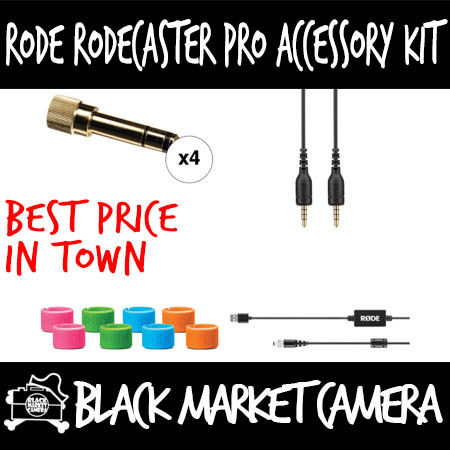Rode RODECaster Pro Accessory Kit Overview
RODECaster Pro Accessory Kit supplies useful items to make podcasting among four friends and one remote guest an easy, coordinated affair. Use the four 3.5mm to 1/4" adapters so people with consumer headphones can monitor their audio. Keep track of who is speaking into which input with the XLR-ID color coordinated rings. Plug a compatible smartphone into the RODECaster Pro with the included TRRS cable. Finally, plug in the RODECaster Pro anywhere you can find a compatible USB power supply with the included USB power cord.
Rode HJA-4 3.5mm to 1/4" Headphone Adaptors
Connect four common consumer headphones to your RODECaster Pro with the RODE HJA-4. This is a pack of four adapters for converting the 3.5mm plugs found on most consumer headphones to the larger 1/4" connections found on most headphone amplifiers. Use these with the RODECaster Pro and the AI-1.
Rode SC9 3.5mm TRRS to TRRS Cable (4.9')
Connect your smartphone or other compatible device to the RODECaster Pro with the RODE SC9. The SC9 is a high-quality cable with two 3.5mm TRRS connections. It measures 4.9' long. Plug one connector into your compatible smartphone, the other into your RODECaster Pro, and you'll be able to route phone calls to your podcast recordings.
Rode XLR-ID Color-Coordinated XLR Rings (Set of 8)
Keep your XLR cables coordinated with the XLR-ID from RODE. The XLR-ID comprises eight color-coordinated rings in groups of two. You get two pink, two green, two orange, and two blue rings. Use the XLR-ID to ensure that four connections to and from your RODECaster Pro remain color coordinated, so you always know who is plugged into which input.
Rode USB Power Cable for RODECaster Pro with Locking Connector
Power your RODECaster Pro with any compatible USB output with the RODE DC-USB1. This power cable lets you plug your RODECaster Pro into any USB Type-A power brick or USB Type-A PSU rated for a minimum of 2.4A. With this cable and your own compatible power source, you'll find the RODECaster Pro is now completely portable.

Medium Format
Medium format refers to the size of your roll of film (or if you’re talking digital, it’s the size of the camera sensor). It really just means that you are shooting on a bigger piece of film than you do with a 35mm camera. The increased size of medium format film means a much larger negative. This will give you finer details and less grain.
Choosing your Right Medium Format Camera
Twin Lens Reflex (TLRS)
TLRs use two objective lens of the same focal length. The photographic objective lens is the one that is used to take the picture. The other lens, called the view lens, is connected to the viewfinder. Most TLRs are fixed focal length, and the more expensive models may incorporate a rudimentary room function. Most TLRs use a leaf shutter system, resulting in high speeds, quiet operation and low shutter vibration. There are also close-up, wide angle and telephoto adapters for TLRs.
Some popular TLRS cameras are: Yashica MAT-124G, Rolleiflex 2.8F, Minolta Autocord and Mamiya C330


Rangefinder
Rangefinder cameras are medium format cameras with a range finder. This negates the waistline, viewing that most TLRs carry. They are also much smaller than TLRs, and allow for easier point and shoot photographs. They tend to have limited focusing ranges, and do not have lenses larger than 180mm or 200mm. Rangefinders are quieter and easier to focus in dim light. They are mostly fixed lens models, but higher range models also provide for interchangeability.
Some popular rangefinder cameras are: Fujica G690, Mamiya 6/7, Bronica RF645, Norita 66 and Pentax 67
WhatsApp Only: +65-8223-7153











